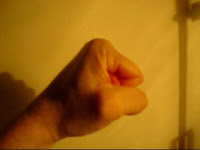Age ura zuki: the rising inverted punch

Introduction The preceding discussion about the uraken or backfist has made me think about the related issue of where backfists occur in karate kata and what techniques are often substituted. In fact only one technique is regularly interchanged with the uraken - the age ura zuki or rising inverted punch. How this technique functions and where it is "exchanged" for the uraken in kata, are very interesting questions. What is an age ura zuki? In Japanese an inverted punch is called "ura zuki". This is commonly performed as a low, short-range, horizontal punch, which stops just after your elbow clears your ribcage. As I discuss in my article " Why corkscrew your punch ", the ura zuki is contained in every standard karate punch. In fact the karate punch goes through 3 distinct stages: 1. First, the chambered punch clears the ribs (ura zuki). 2. Second, the punch extends into a mid-range vertical fist punch (tate ken zuki). 3. Third, the punch corkscrews ...


